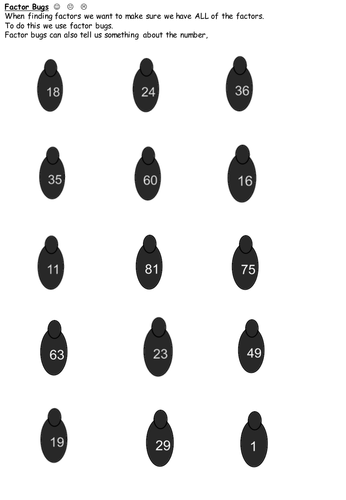
A quick worksheet on practising the factor bugs method of finding the factors of a number.
The factors "1 and itself" are the antennae and the other factors as the legs, and if it is a square number the "square root" is written as the tail (e.g. For 16, 1 and 16 will be the antennae, 2 and 8 will be the legs and 4 will be the tail).
I always ask students to tell me about why some bugs are different.
"Which bugs only have antennae? Why? What are they called?"
"Which bugs have tails? Why? What are they called?"
"Explain what is different/strange about the 1 bug"
The factors "1 and itself" are the antennae and the other factors as the legs, and if it is a square number the "square root" is written as the tail (e.g. For 16, 1 and 16 will be the antennae, 2 and 8 will be the legs and 4 will be the tail).
I always ask students to tell me about why some bugs are different.
"Which bugs only have antennae? Why? What are they called?"
"Which bugs have tails? Why? What are they called?"
"Explain what is different/strange about the 1 bug"
Something went wrong, please try again later.
Great idea
Report this resourceto let us know if it violates our terms and conditions.
Our customer service team will review your report and will be in touch.
£0.00
